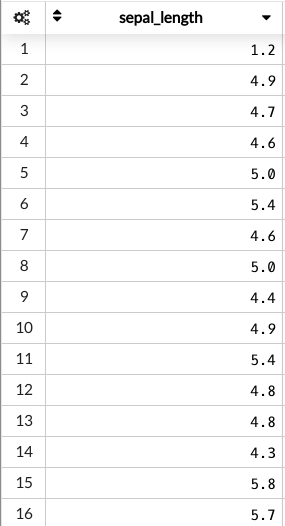Using the Data Table Editor
The Data Table Editor enables workspace users to quickly and easily edit, modify and create new data tables in a fully audited process. This tool allows you to manually prepare your data for medical statistics from within your workspace, including:
- editing data tables inline, in a point and click manner
- manually transcribing or modifying data by creating new tables
- loading and editing existing data frames
Cell by cell auditing ensures that any changes to existing data, or the creation of new data, is captured and recorded by your workspace’s audit functionality to maintain version control and traceability.
Using the Data Table Editor
To access the Data Table Editor functionality, select a data table or a CSV file, and click on the ‘Analyse Data’ button in the menu. This will open the selected data table or CSV file for editing. Please note that if you open a table that is larger than 250 000 cells, the Data Table Editor will open in sample mode and you will not be able to edit the data, only view it. Sample mode can only be used on data tables, not on CSV files so if you want to open data that is larger than 10 MB you need to convert your CSV file to a data table. You can read more about sampling mode in this article.
Moving around your data table is simple. You can navigate through the cells using the standard keyboard just like in any other table using the up/down arrows, tab, etc.
The toolbar at the bottom of the page provides functionality to easily explore the data table.

It is also possible to search for specific content via the search field found at the bottom of the page. Click 'Enter' to display the next result. Please note that you must enter 3+ characters (letters or numbers) in order to use this search functionality.
The ‘Undo’ and ‘Redo’ buttons at the bottom right of the screen can be used to fix editing errors. Up to 10 changes can be reversed using the ‘Undo’ function.
Adding rows or columns
You can use the ‘+ Cols’ or ‘+ Rows’ buttons located at the bottom left of the page to add columns or rows to your data table.

Alternatively, you can click the cog icon at the top left of the table and click on ‘Add Row’ or ‘Add Column’ as required.
Please note that new rows and columns can not be added if you are in sampling mode.
Editing, hiding and deleting columns

To edit a column, select the dropdown arrow at the top of the column and select ‘Edit Column’. This will open a new window, which allows you to change the name of the column and select the data type – text, numeric, boolean, or date and time – from the list. Should a column type be changed to an invalid format (e.g. if you attempt to change a column containing numerical content to a text format) you will receive an error message. The ability to edit columns is not available in sample mode.

To delete a column, select the dropdown arrow at the end of a column and click ‘Delete’ to delete it from the table. If this is done in error, it can be reversed by clicking the ‘Undo’ button. The ability to delete columns is not available in sample mode.
To hide the column, select the dropdown arrow at the top of the column and select ‘Hide’. To unhide a column, click on the cog icon at the top left of the table, select ‘Show Column’ and choose the one you wish to show from the list.
You can also display column data types by clicking on the cog icon at the top left of the table and then selecting ‘Show Column Info’. You also can hide the column data types using the same menu.
Sorting the data

To quickly sort the rows of data by primary key, click on the cog icon at the top left of the table and select ‘A-Z’ to sort from smallest to largest, or ‘Z-A’ to sort from largest to smallest value.
To sort your data by one or more columns, click the up and down arrow icon on the left of the column name. Clicking once will sort the data in ascending order, twice - in descending order. Clicking three times will clear the sort. The example below shows data sorted by the extent and then by time.

Changing the primary key

To change the table's primary key, click on the cog icon at the top left of the table and select 'Set Primary Key'. Columns that meet the criteria for a primary key (no duplicate values in the first 10 GB), will be displayed. Click on the column that you want to use as the new primary key of the table.
Inline editing
Inline editing is done easily by clicking on a cell to quickly adjust the data in real-time. If data of an incorrect type for that cell is entered, it will be flagged as an error and the field will be highlighted in red. Inline editing is not available in sample mode.

Data Table Analytics

Clicking on the cog icon, and then selecting the 'Show Analytics' option opens the Data Table Analytics sidebar on the right. The tool offers over 20 medical statistics modules that enable quick visualisation and analysis of data.
The Data Table Analytics sidebar can be hidden using the 'Hide Analytics' option in the menu.
Saving a data table
Updated data becomes immediately available for use within the workspace, simply click the 'Save' button once the required edits have been made.
To use the data table outside the workspace, click on the cog icon, then select 'Save as'. This will open a new window, where you can choose to export the edited table as a CSV file. The CSV file then can be downloaded from the workspace using the Airlock function. This exported file is for offline use only and would then not be available for use within the workspace.
